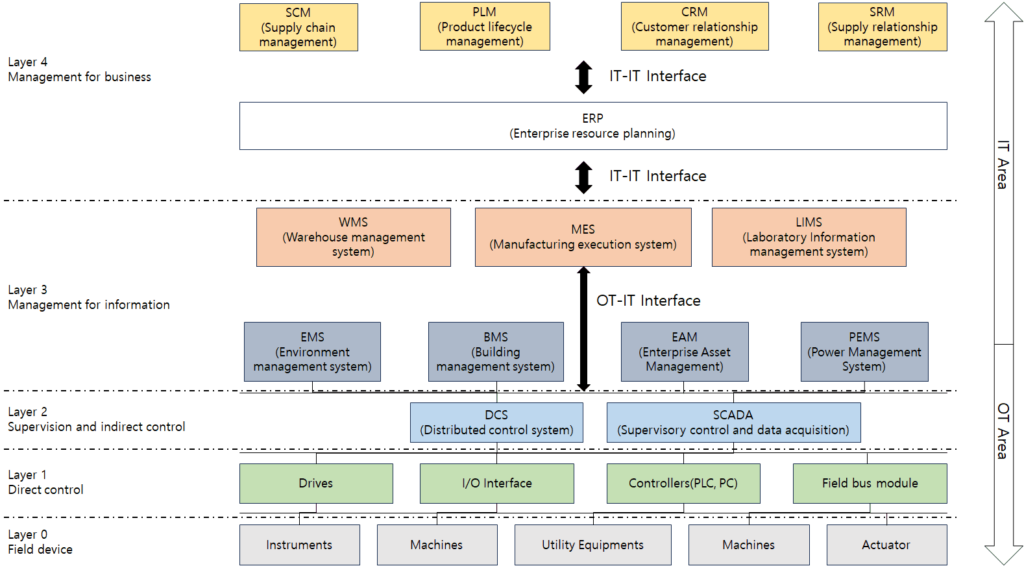A Detail Overview of ISA 95 Model for Industrial Automation
As explained in the previous article (What is IT and OT ? : Convergence in the 4th industrial revolution), IT & OT understanding and Convergence are very important. And to understand and implement IT & OT Convergence, it is very important to know the ISA 95 Automation Pyramid layer. In this article, I will explain the ISA 95 Model in detail and explain a little deeper theory and practice. (Based on my experience)
1. Details of ISA 95 automation pyramid layer
According to the author’s experience, the Smart Factory Automation layer(or called automation pyramid) of ISA 95 can be explained in detail as follows. Generally, Layer 0 to 2~3 are called OT area, and Layer 3 to 4 are called IT area.

- Layer 0 (Field device)
The foundation of the Automation Pyramid is layer 0, encompassing the physical processes, equipment and sensors within an industrial facility. This layer comprises sensors, actuators, motors, and other devices responsible for direct interaction with the physical world. Layer 0 generates real-time data through measurements, providing invaluable information regarding the status and performance of the industrial processes. - Layer 1 (Direct control)
Above layer 0 is layer 1 which incorporates physical equipment or sensors or controls that monitor and control the facility. This layer includes programmable logic controller (PLC), PC, Communication modules and similar devices that run control algorithms to regulate and optimize equipment operation. Layer 1 is a bridge between physical processes and higher-layer(level) systems involved in decision-making and management. - Layer 2 (Supervision and indirect control)
Layer 2 of the Automation Pyramid represents the supervisory control layer responsible for coordinating and supervising the control devices at Layer 1. This layer encompasses SCADA(Supervisory Control and Data Acquisition) systems and DCS(Distributed Control Systems) that collect data from multiple control devices, offer real-time visualization of processes, and enable operators to monitor and manage industrial operations. Layer 2 serves as an intermediary between the control devices and the higher-layer(level) enterprise systems. - Layer 3 (Management for information)
Further up the automation pyramid leads to Layer 3, which represents a hierarchy commonly referred to as MOM(Manufacturing Operations Management). This layer contains management systems for information. It also focuses on optimizing and managing the manufacturing process, including production scheduling, resource allocation, quality control and performance analysis. MOM systems integrate data from a variety of sources, including Layer 2 SCADA systems, to provide a holistic view of production operations and enable informed decision-making.
At this time, the interface between SCADA System (OT) and MES System (IT) is very important. This is the core of IT-OT Convergence. The same goes for LIMS. IT-OT Convergence can be implemented through the interface with LES (Laboratory execution system), an OT area. In other words, layer 3 systems make good use of layer 0 and layer 1 data gathered in layer 2. - Layer 4 (Management for business)
At the pinnacle of the Automation Pyramid rests Layer 4, which encompasses the enterprise integration layer. This layer incorporates business and management systems that connect industrial operations with broader enterprise functions such as inventory management, supply chain, finance, and customer relationship management. Layer 4 facilitates seamless integration and information exchange between the shop floor and enterprise systems, fostering strategic planning, resource allocation, and business intelligence.
In particular, the interface with Layer 3 is important in that layer. Because through the interface between IT and IT, manufacturing-related data can be utilized in business.
2. By my experience
Building each system independently is difficult. However, the most difficult is the interface between systems (or between IT & OT and IT & IT). Most smart factories and suppliers also find it very difficult to build them. In the case of Korea(called an IT powerhouse), almost all factories do not know this properly and build it, making it difficult.
Therefore, the concept and interface of each system should be carefully reviewed. In order to do that, you need to know these basic concepts, right? There will be many rather unfamiliar concepts. However, they are all essential to building a complete smart factory. If you need more information, can contact us via to e-mail.
3. Conclusion
The ISA 95 Automation Pyramid presents a structured framework for comprehending the different layers and their interrelationships within industrial automation systems. By adopting the principles of the Automation Pyramid, organizations can achieve seamless communication, efficient control, and effective decision-making across all levels(=layers) of the industrial hierarchy. Understanding the significance of each layer within the Automation Pyramid is crucial for designing, implementing, and optimizing industrial systems aligned with the goals of Industry 4.0 and the digital transformation of manufacturing.
Building each system independently is difficult. However, the most difficult is the interface between systems (or between IT & OT and IT & IT). Most smart factories and suppliers also find it very difficult to build them. In the case of Korea, almost all factories do not know this properly and build it, making it difficult.
Therefore, the concept and interface of each system should be carefully reviewed. In order to do that, you need to know these basic concepts, right? There will be many rather unfamiliar concepts. However, they are all essential to building a complete smart factory. If you need more information, can contact us via to e-mail.